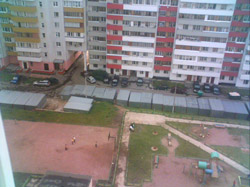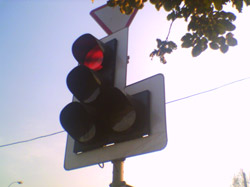|
|
Review of the PDA Fujitsu Siemens Pocket LOOX 720
Live pictures
Official photos
Standard kit :
- PDA
- Extra stylus
- USB cable for synchronization and plugging USB-devices
- Docking station
- Carrying case
- CDs with the software
- Voucher for applications from http://pocketloox-choice.com

Almost 10 months have passed since the release of the first Pocket PC with a VGA screen. The appearance of Toshiba e800 proved to be a turning point in the development of Pocket PC. However a mass release of Pocket PCs with VGA screens is outlined only now. In the upcoming months or weeks there will be offered for sale five such Pocket PCs (not counting various modifications) at a time: Asus A730, Fujitsu Siemens Pocket LOOX 720, Toshiba e830, HP iPaq hx4700, Dell Axim X50. Each model is interesting in its own way. Not long ago we’ve written about Asus A730, today we are testing a handheld computer Fujitsu Siemens Pocket LOOX 720. The tests of other VGA-Pocket PCs will be available as these handhelds appear in our test laboratory.
The first Pocket PC by Fujitsu Siemens, the LOOX 600, was one of the best Pocket PC in 2002, it enjoyed high sales. A year after, i.e. in 2003, the company launched the Pocket LOOX 610, which was a full copy of Asus A716. The model turned to be a specific one. Featuring good specifications it had a “brick” size, external antenna, difficult implementation of wireless adapters and was overpriced. For example, the modification LOOX 610 without Wi-Fi lost to HP iPaq model in most characteristics. The users of the first handheld in the series were disappointed.
A whole year passed by, and we see that Fujitsu Siemens has introduced a very strong line. The company extended the model line with several budget handhelds: Pocket LOOX 410 and 420. The new “top” Pocket LOOX 700 series include two models. The LOOX 720 succeeds to FS Pocket LOOX 600. It seems to rival with HP iPaq 4700 for the award the best Pocket PC of this year. The junior model Pocket LOOX 710 represents a simplified version of the Pocket LOOX 720: it lacks the camera and comes with twice as less RAM, less frequency rate, QVGA screen instead of VGA. Both models together with HP iPaq 4700 and Dell Axim X50 modifications are developed and manufactured by the Taiwanese company HTC (the project name of the LOOX 720 is HTC Bali). By the way, HTC is a hardware platform development partner of Microsoft; no wonder that most Pocket PCs are made at the plants of this company.
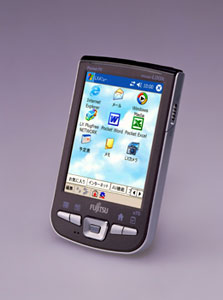
Let’s note the following. Our site was the first to publish photos of the Pocket LOOX 720, but we mistakenly supposed it was a copy of Asus A730. In fact there is another handheld Fujitsu Pocket LOOX v70, which is a full copy of Asus A730 to be released on the Japanese market only. So, Fujitsu Siemens Pocket LOOX 720 is the model for the global market and is offered by another manufacturer (HTC instead of Asus), though the specifications remind greatly those of Asus A730W. Well, that will do for the introduction, let’s pass over to the review.

The size of the LOOX 720 is like that of Asus A730, if you don’t put them together, you’ll hardly see the difference. The device is slightly taller that, for example, HP iPaq 2210, but it is much smaller against Toshiba e800. The handheld lies comfortably in hand, it doesn’t slip mostly due to the side grooves in the style of Sony Ericsson t610/630. Given the fact, the LOOX 720 is equipped with two slots for expansion, its size is close to be optimum, unless the length could be shorter.
- Toshiba e800/e830: 134.6õ76.2õ15.2 mm 192 g
- HP iPaq 4700: 131x77x14.9 mm 186.7 g
- FS Pocket LOOX 720: 122õ72õ15.2 mm 170 g
- Asus A730: 117.5õ72.8õ16.9 mm 170 g
- HP iPaq 4150: 113.6õ70.6õ13.5 mm 133 g
The LOOX 720 weighs 170 g – not a lightweight handheld, but that’s typical for the devices with two slots. Besides a high capacity battery adds greatly to the total weight.
Design and the color solution are typical for the latest PDAs by Fujitsu Siemens: nice dark grey plastic and silver edging, smooth, but strict lines. In all, design leaves very pleasant feelings, the PDA has its own image – stylish, but not flashy. As for design it’s hard to be objective, somebody might not like it. The assembly quality proves to be very high, all details fit perfectly. Such a high quality is common for the products made at the plants of HTC. We advise you to treat the casing carefully, remember the plastic is colored, and the color might peel off, if you carry the handheld without a case.

The 5-directional navigation pad is located traditionally under the screen. We tested it with the latest version of the emulator MorphGear, the pad didn't fail working good in 8 directions without delays. However the buttons didn't look that good, there was a certain lag (a delay after a button is pressed) like in Toshiba e800. The delay lasts for a fraction of a second, but it's a crucial point in games, especially when the hero shoots or jumps in the wrong time. Gamers should pay a special attention to this moment. In other aspects the buttons are quite comfortable featuring an average size and the press response. Application buttons around the D-pad are like in the 400-series. To the left there are standard ones, to the right there are Home and E2C buttons (useful during a wireless connection). Additionally you can choose a second set of applications to launch if you hold any of these buttons down: the launch of any application installed, the launch of the input panel, the context menu, “ok/close”, the screen rotation, the return to the start screen, “Start” menu. The lag occurs because the hold function is active. The buttons are easy to press and followed by a sound response. Using the built-in application FSC Keylock, you can lock the keys to avoid an occasional key pressure. To the right from the D-pad there is a dynamic, which is loud enough and doesn't chatter at the maximum sound level.
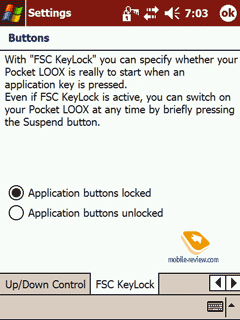 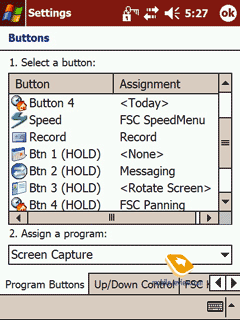
Above the screen there is an extra dynamic for VoIP-telephony via Wi-Fi, i.e. within a Wi-Fi network it is possible to use the PDA without a headset as a common phone. Two LED indicators are located by sides from the dynamic. The right one displays Wi-Fi work glowing green and Bluetooth glowing blue, the indicator blinks green and blue by turns, should both adapters be on. The other indicator stands for missed events and gives signals when the device is being charged or is fully charged. On/off button is located at the front panel too.
The right side carries the voice recorder button. The left side has the button launching FSC Speed Menu, hold it down to start the camera. Besides there is a scrolling wheel here, that can rarely be found in the recent handhelds, as many manufacturers have renounced it. The scrolling wheel is very comfortable as it should be, use it to browse e-books and documents – that’s the main assignment. In this very aspect the given model keeps traditions of FS Pocket LOOX 600. Here you can find the hole for the strap. The handheld feels heavy to wear it on the neck, but it’s quite comfortable to carry on the hand strap.

At the top there are two slots for expansion, standard 3.5 mm headphones jack. The quality of MP3 playback proved perfect, for a week I’ve been listening to the music on the LOOX 720 with a great pleasure in transport. The test involved Koss KSC-50 headphones, encoding music files at 320 kbps and Pocket Music 3.0 program player. Well, we got a high quality sound without the distortion of upper and lower sounds. The test revealed no problems at the maximum sound volume. The infrared port located nearby can be used to control home electronics – it supports CIR.

The silo occupies its standard place at the top corner, not at the bottom like in the case with Asus A730. The stylus has an average size and is easy in work. It isn’t a telescopic one, but it can be untwisted (in order to reset the device).
The back panel hides the camera and the battery compartment. We’ll discuss them a little bit later. Note, the battery cover has a rubber band, so the device doesn’t slide on the surface – another plus in the ergonomics of the device.

The bottom end contains the reset button (you should untwist the stylus to press it, as we’ve written above), the microphone and the connector to plug the cable or the cradle. We’d mark the microphone. It’s very sensitive, for example it’s possible to make out words said quietly within 2-3 meters distance, even if there were some other sound sources. The recorded sound is clean and has almost no noise. To tell the truth, until now I’ve never come across such a high quality microphone in other handhelds.


The docking station isn’t big. It doesn’t firmly fix the handheld making it loose. There is a slot and a light indicator to charge a spare battery. You can recharge the handheld using either the cradle or the cable. So you don’t need to have the docking station always with you.

The standard kit includes a simple leatherette carrying case free of any fastening elements (the same for HP iPAq 2210 and HP iPaq 4150). However the fact it comes with the handheld gladdens. Its cheap look and the simplicity do not comply with the high-end PDA, to my mind. It will protect the device for the initial period, but with the lapse of time you’d better replace it with a suitable case.
Screen
The LOOX 720 is equipped with a 640x480 pixel, 65K color screen. Official specifications suggest 3.6” diagonal, actually it is a little bit shorter – about 3.58” (the active area, measured by the ruler). Toshiba e800 and Asus A730 feature larger screens – 4” and 3.62” respectively.
Compare the photos below of different Pocket PCs (the left top corner of Today screen) to see the difference between VGA and QVGA screens. On a VGA screen everything looks more detailed: icons, fonts and especially photos and movies.
QVGA:

VGA:

Now let’s talk about the quality of the screen. Toshiba e800 and Asus A730 are equipped with SG Silicon screen made by Sharp (both screens are comparable, only Asus screen renders white colors a bit worse than Toshiba), in the case with FS Pocket LOOX 720 a VGA matrix by Sony is used. It noticeably differs from SG Silicon: subjectively the image is somewhat contrast, the main distinction involves good viewing angles. You can view the image at a zero angle, besides colors almost do not get inverted, if you take a side view. If you look from above, the acceptable angle makes up 45 degrees. Well, let’s not scrutinize the screens too closely and say, they are all comparable, the only crucial point involves viewing angles and the diagonal.


There are 11 backlight levels, the minimum level is quite comfortable for working in the dark, but it’s slightly higher than in HP iPaq 2210 (given that it can be considered the etalon).
Very soon all new Hi-End Pocket PCs will be equipped with VGA-screens, and later that will happen to all Mid-Range Pocket PCs. In a year or two VGA-screens are to completely replace QVGA, as in due time color screens forced out monochrome ones. That’s our forecast.
Interface
FS Pocket LOOX 720 comes with two wireless adapters, which is no longer a novel fact, but the barest necessity. For example, the new HP iPaq line includes only one handheld without both adapters, the rest models come with Bluetooth and Wi-Fi. Step by step this becomes a common feature for Pocket PC, like IrDA. Remember just two years ago the integrated Bluetooth module was a rarity, so one could only dream about two integrated wireless adapters.
Earlier in the Pocket LOOX 610 the adapters didn’t work simultaneously, there were own Bluetooth drivers and no-esthetic looking external antenna. Compared to the LOOX 610 the LOOX 720 makes a step forward. Firstly, both adapters can work simultaneously. Secondly, the standard Bluetooth drivers are involved. Thirdly, there is no external antenna.
 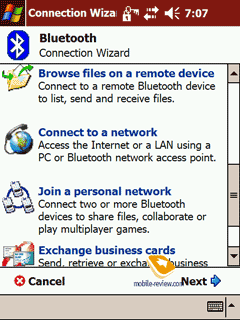
Bluetooth 1.2. As we’ve already said, the LOOX 720 has the standard drivers WIDCOMM Bluetooth for Windows CE BT-PPC (1.5.0 Build 1800 version), like for Asus A730 and the overwhelming majority of other Pocket PCs with Bluetooth. Automatically the existence of WIDCOMM drivers means the maximum functionality of Bluetooth. As it was expected everything ran without bugs and failures: the Internet connection via Sony Ericsson t630 and Motorola MPx220, File Transfer, Information Exchange, Serial Port, Dial-up networking server, audio gateway.
Here is the full list of the profiles supported: BNEP, DUN-DT, FT-Client, GAP, File Transfer, Object Push, OPP Client, Point to Multipoint (PAN), FT-Server, LAN-DT, Point to Point (LAP), OPP Server, PAN-User, SDAP, SDP, SerialDevA, SerialDevB.
By the way, we mentioned the name WIDCOMM by force of habit. Recently the company Broadcom has absorbed WIDCOMM. So now we see the name Broadcom instead WIDCOMM in drivers' properties. We want to believe, the company acquisition will tell upon the quality of the Bluetooth software, which has become the industry standard for Pocket PCs and desktops powered by MS Windows.
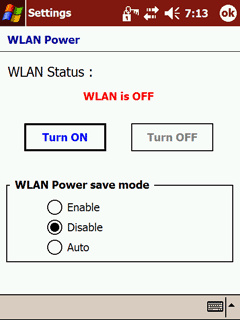
Wi-Fi. The adapter worked good with a home access point within a 3-room flat: no rebukes, the sensitivity of the receiving antenna is high. The only thing that I didn't like is the program implementation of Wi-Fi: poor Wi-Fi manager settings, the lack WPA support (Wi-Fi Protected Access, at the moment this standard is considered safe, follow the link to learn more about it). There is only the support of a vulnerable encoding standard WEP 128 bit.
The utility E2C controls Wi-Fi settings. You can create a profile for only one wireless network, the scanner doesn’t recognize networks with a latent SSID, there are specific problems for entering a WEP-key. Well, as I’ve already said the settings are poor. The problem can be solved with some exterior Wi-Fi managers. Besides there is a professional version of E2C, but you should acquire it additionally.
In all, the problems with Wi-Fi don’t seem to be dramatic, just install an exterior Wi-Fi manager. Put up with the software roughness, and the LOOX 720 will do for the use with the home access point. The WPA support might appear in upcoming software versions, probably by the commercial launch.
FS Pocket LOOX 720 can be used as an IP-phone in Wi-Fi networks. You can use a Bluetooth-headset or manage without it (there is an extra dynamic).
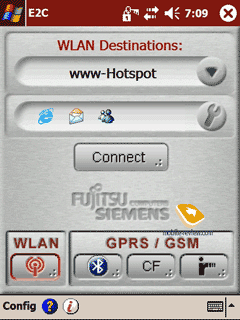 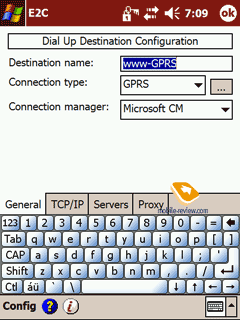
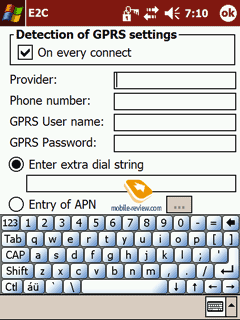 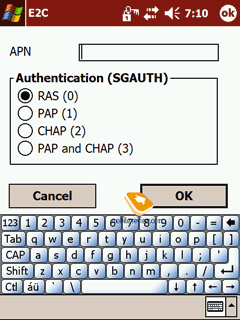
CONNECTMOBILITY-E2C. We’d rather pay special attention to the utility E2C. This application accounts for the Internet connection via any interface (Bluetooth, Wi-Fi, IrDA, CF-GPRS). The GPRS settings got very easy and facilitate the connection process for a beginner.
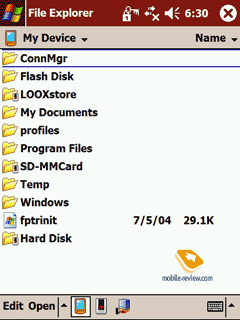
USB. The standard kit includes a combined USB-cable (USB Host and USB client). You can plug different USB-devices via the cradle or skipping it. For example – a camera, USB-flash or USB-keyboard. For other devices you’ll need drivers for Pocket PC. The official Russian shipments include the russificator by Paragon, which will come with drivers for the Russian USB-keypad, the same is for Asus A730. The device can be charged via the USB-cable, but the process lasts longer compared with the socket charging.
As for the device interfaces, the opportunities are ultimate. Two slots for extension – SD/MMC with the support of SDIO, Compact Flash Type II. Two wireless adapters – Bluetooth and Wi-Fi, which can work simultaneously. The infrared port allows controlling home electronics (it supports the consumer infrared standard – CIR). There is also a USB-host. In other words, the same story as with Asus A730W, however in this case the USB-cable to plug other USB-devices is supplied.

Battery
The LOOX 720 is fed by a 1640 (!) mAh removable Li-Ion battery. Such a capacious battery roused a definite optimism before the tests. The manufacturer claims 12 hours of a continuous work. The tests revealed the following results. The LOOX 720 lasted for 7-8 hours at a common use (books, organizer, GPRS, some video and music) with an average backlight level. Under the maximum load (the maximum frequency rate, maximum backlight, playback of a large clip) the battery was completely emptied after 2 hours 45 minutes. After the backlight level was lowered to 1/3 the handheld was good for 3 hours 35 minutes under the same mode. Under the MP3 mode (the screen is on, the minimum frequency rate) the provided 11-12 hours on a single charge. We expected better results for the MP3 mode (up to 20 hours), however the average time of the usual use and the time for the video playback justified our hopes.
Camera
 The camera lens is located at the back panel, it has no shutter and isn’t dipped. On the one hand, it won’t be covered with dust, but on the other hand the lens can be scratched. However during our tests and the use without a case nothing happened to it. Here you can find a flash and a mirror for the self-portrait. The flash is almost useless, as it is effective within a 50 cm distance (like in Asus A730), besides it is idle while shooting video files. The camera lens is located at the back panel, it has no shutter and isn’t dipped. On the one hand, it won’t be covered with dust, but on the other hand the lens can be scratched. However during our tests and the use without a case nothing happened to it. Here you can find a flash and a mirror for the self-portrait. The flash is almost useless, as it is effective within a 50 cm distance (like in Asus A730), besides it is idle while shooting video files.
As in the case with Asus A730 the camera in FS Pocket LOOX 720 features a 1.3-megapixel matrix. Taking into account the picture quality it’s difficult to tell the leader. Naturally the quality is much worse if compare with any budget digital camera.
You can choose between JPEG and BMP formats to record photos. There are less variants of the resolution available compared with Asus A730:
- XL – 960x1280
- Large – 480x640
- Medium – 240x320
- Small – 120x160
There are the following modes to shoot photo and video files: Auto, Daylight, Incandescent, Fluorescent, Night, Grayscale, Sepia, Cool, Negative. You can manually adjust the following parameters: Contrast, Brightness, Saturation, Hue, Gamma, Sharpness. In the settings you can specify the destination folder for the photos, switch off the sound during recording video clips and disable the shutter sound. For video files you can also set the size in kilobytes, by default the clip size is limited to the memory available. There is a 2x digital zoom. Video files are recorded in MPEG-4 or Motion JPG AVI formats. The resolution available:
- Large – 288 x 352
- Medium - 144 x 176
- Small – 96 x 128
Compare photos made by Asus A730 and Pocket LOOX 720:
Other examples of pictures by Pocket LOOX 720. We don’t publish the photos made indoors and in the dark, as the quality turned to be very low:
The example of a video clip, as you see, the quality leaves much to be desired:
Example of a video clip (mp4, 130 Êá)
Here is a short resume on the camera: this 1.3-megapixel camera hasn’t made a surprise. It is comparable with the analogs, but it lags far behind from budget digital cameras. To tell the truth, the existence of a camera in a handheld seems to be a plaything, a fashion element. It is good for a report/diary shooting, but not for an advanced use. By the way the corporate use of camera-enabled handhelds might be restricted for the sake of security.
Productivity
The user can access a little more than 123 MB of RAM from 128 MB and also 29 MB of non-volatile flash-memory. Everything is good here.
The LOOX 720 is powered by Intel XScale PXA272 520 MHz processor. The most PDA makers has already switched to this processor (at least for the top models), much rarely you can come across the processors by Samsung and TI. 520 MHz of frequency isn’t the maximum for the PXA27x processor. For example, HP iPaq hx4700 features 624 MHz. When you decide which model to buy, pay little attention to the frequency rate. During tests we safely sped up the LOOX 720 up to 624 MHz.
We used the SPB Benchmark package to test the productivity of the handheld. For this purpose we applied test results of the models with VGA-screens, previous Pocket LOOX models and the iPaq 4150. In order the test results for VGA-Pocket PC could be comparable we sped up Toshiba e800 to 528 MHz.
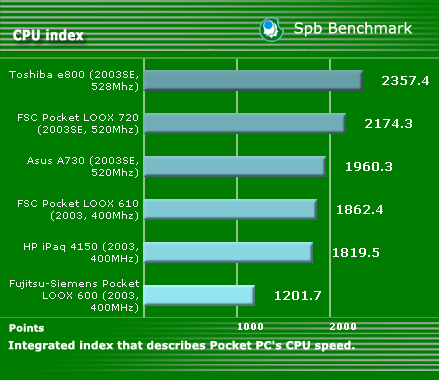
The “old” sped-up Toshiba e800 is leading with the CPU index, that can be related to a higher frequency rate and the speed-up specifics. The LOOX and Asus are slightly behind.
I think we should comment on the following point. Here and farther in the tests Asus A730 performs worse than the LOOX taking into account the fact that the hardware in both models is almost the same. With our test results we applied to the head office of Asus and received an official affirmation that under the final version of the software Asus A730 would work “to 3 times faster”. So let’s wait and see, I’d take the model for the tests for the third time, this time from the retail. Naturally we tell our readers about the new results, and as for now, let’s return to our review.
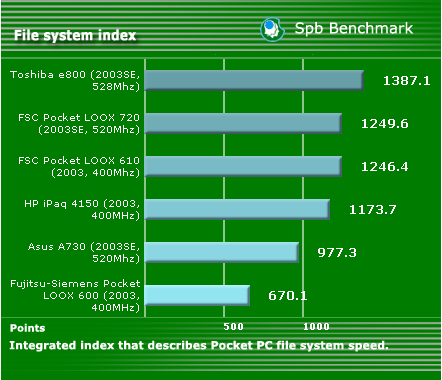
The file system index describes Pocket PC file system speed (read/record/move). Toshiba is still leading, and the LOOX lags slightly behind.
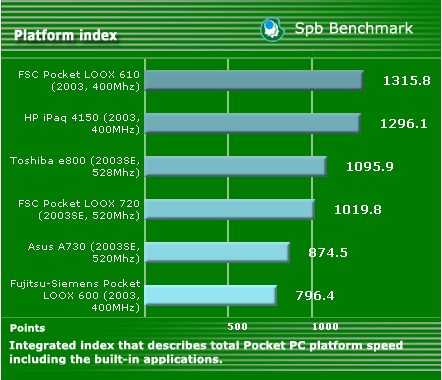
The platform index describes total Pocket PC platform speed including the built-in applications. Here the high resolution takes effect, and QVGA-screen PDAs break away.

The graphic productivity test has bad implementation in the SBP Benchmark package, it delivers a vast spread, the results cannot be interpreted, it distorts the total index.
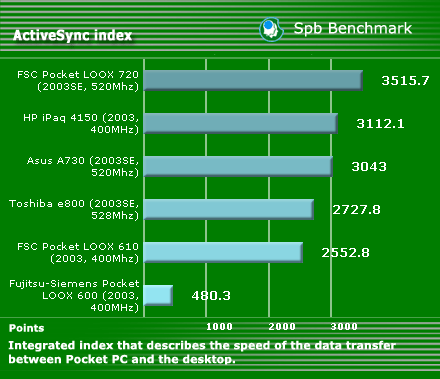
With the synchronization speed FS Pocket LOOX 720 suggests record figures.
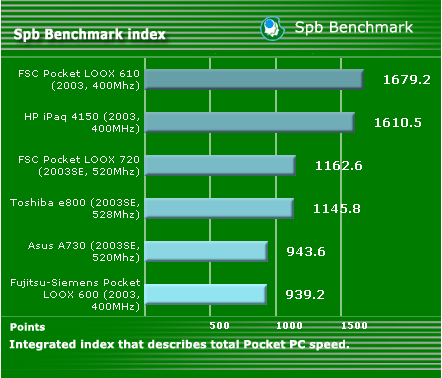
The integrated index describes total Pocket PC speed. In the whole, this index reflects the real position of the handheld in the speed aspect, but do remember it is distorted by the incorrect graphic productivity test (the performance of PDAs with VGA screens is lowered).
We tested video with the
BetaPlayer 0.04, see the results in the table below. The speed is set in percents, the more it is, the faster the PDA is. Approximately 120% and higher – video is played smoothly without dropped frames, at 100% video can drop during active scenes. Toshiba e800 was sped up to 528 MHz and the LOOX 720 – to 624 MHz, however neither FS LOOX nor Asus has a built-in accelerator like Toshiba e800 with ATI Imageon, which noticeably speeds up the video playback. Toshiba is leading with the default settings, moreover in a simpler clip it has a better advantage against the Pocket LOOX.

Should we disable a smooth scaling and halftones (the fact doesn’t affect the picture quality), the LOOX 720 has a breakaway at the most difficult clip, but despite the lack of a graphic accelerator Toshiba returns the leadership at a simpler clip. The test results make us think whether a graphic accelerator is needed. Do we need it? At the moment the productivity of the LOOX 720 is enough to complete any task for the handheld, including the video playback.
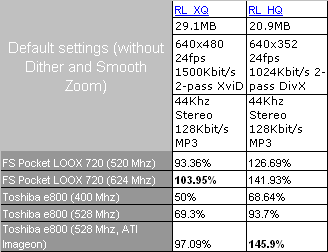
I forgot to mention, you can choose the processor frequency rate of set the auto mode:
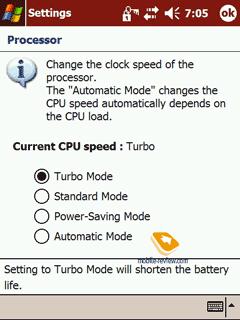
Software
The handheld is powered by the operating system Windows Mobile 2003 Second Edition. You can learn more about its opportunities in the respective article published on our site (the review has been recently updated with the release of an important utility SE_VGA). So here we deal with non-standard built-in applications.
E2C. We wrote about it in the chapter “Interface”.
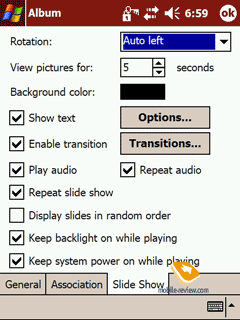 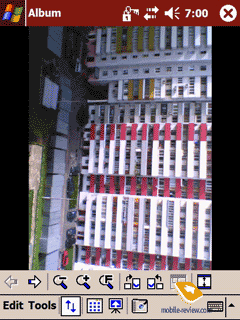
Album. An advanced utility by HTC to view pictures and video clips. You can arrange photo-presentations and slightly edit your photos.
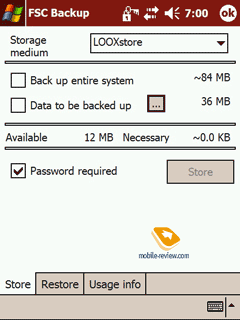 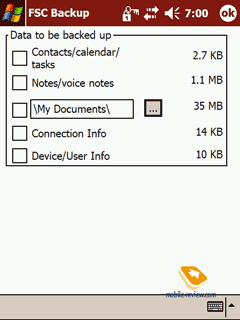
FSC Backup. The program executes a backup. It’s possible to choose whether to copy all the data from RAM or just favorite files. As for shortcomings, you can’t run the application on the schedule, and there isn’t an automatic data backup when the batter is low.

FSC Speed Menu. It’s an analog of Start button, but it is much flexible and advanced, that is nice – you can easily adjust it for your own needs by adding necessary applications and folders.
Conclusion
FS Pocket LOOX 720 will be offered for sale these days. In Russia it will also appear very soon. The price will make up $675. Compare it $650 for HP iPaq hx4700 and $600 for Asus A730W. The LOOX 720 seems to be the most expensive from the new Pocket PCs. As a result of a tough competition the price for the Pocket LOOX 720 might fall to $600 or lower by the end of the year. Given the fact that Dell Axim X50 is made by the same company HTC (not by Wistron as the Axim X5), Dell will hardly knock down prices for Pocket PC. But we won’t make any hasty conclusions.
The handheld has ultimate features: two slots for expansion, two wireless adapters, USB-host, large RAM, VGA-screen, long battery life. The processor performs well during tests and under real conditions. The LOOX 720 comes with a nice design and a well thought-out ergonomics (grooves at sides, the scrolling wheel), unless the buttons have a lag. The microphone quality is the highest. The screen isn’t a large one, but its quality makes it the best compared with Toshiba e800 and Asus A730 (consider viewing angles). I am not praising the device, I’m just enumerating the facts. To say the truth, it’s very hard to find faults with the LOOX 720. Its only weak point is the price, besides the fans of Toshiba e800 and HP iPaq 4700 might say, the comfortable work with the VGA screen is possible only at 4”.
The LOOX 720 represents a Hi-End PDA of the second half 2004. Two wireless adapters, VGA-screen, Intel XScale PXA27x processor, WM2003SE operating system – we’ll meet such a combination many times in our future reviews very soon. I wonder who will be the first to release a handheld with the VGA screen and a single slot for expansion…
Description:
- Class: Hi-End
- Position in the line: above Pocket LOOX 710
- Rival models: Toshiba e 830, HP iPaq 4700, Asus A730W , Dell Axim X50
- Operating system: Windows Mobile 2003 Second Edition
- Processor: Intel XScale PXA272 520 MHz
- RAM: 128 MB (123.23 MB available to the user)
- LOOXstore (flash-memory available): 28.68 MB
- Connectivity: SD/MMC slot (SDIO support), Compact Flash Type II, IrDA (Consumer infrared), Bluetooth 1.2 Power class 2, IEEE802.11b (Wi-Fi, chip maker – Texas Instruments), USB (1.1 slave, 1.1 host)
- Extra dynamic for IP-telephony via Wi-Fi
- Screen: 3.58” (active area: 55.5x73 mm), 640x480 pixels, 65K colors
- Camera: 1.3-megapixel (image size – up to 980x1280 dots), video clips, flash
- Battery: removable Li-Ion 1640 mAh. Battery life claimed: 12 hours active, 15 days standby. Backup battery life – 30 minutes
- Dimensions: 122õ72õ15.2 mm
- Weight: 170 g
Anton Kotov
([email protected])
Translated by Anja Rytchkova ([email protected])
Published - 7 September 2004
Have something to add?! Write us... [email protected]
|
News:
[ 31-07 16:21 ]Sir Jony Ive: Apple Isn't In It For The Money
[ 31-07 13:34 ]Video: Nokia Designer Interviews
[ 31-07 13:10 ]RIM To Layoff 3,000 More Employees
[ 30-07 20:59 ]Video: iPhone 5 Housing Shown Off
[ 30-07 19:12 ]Android Fortunes Decline In U.S.
[ 25-07 16:18 ]Why Apple Is Suing Samsung?
[ 25-07 15:53 ]A Few Choice Quotes About Apple ... By Samsung
[ 23-07 20:25 ]Russian iOS Hacker Calls It A Day
[ 23-07 17:40 ]Video: It's Still Not Out, But Galaxy Note 10.1 Gets An Ad
[ 19-07 19:10 ]Another Loss For Nokia: $1 Billion Down In Q2
[ 19-07 17:22 ]British Judge Orders Apple To Run Ads Saying Samsung Did Not Copy Them
[ 19-07 16:57 ]iPhone 5 To Feature Nano-SIM Cards
[ 18-07 14:20 ]What The iPad Could Have Looked Like ...
[ 18-07 13:25 ]App Store Hack Is Still Going Strong Despite Apple's Best Efforts
[ 13-07 12:34 ]Infographic: The (Hypothetical) Sale Of RIM
[ 13-07 11:10 ]Video: iPhone Hacker Makes In-App Purchases Free
[ 12-07 19:50 ]iPhone 5 Images Leak Again
[ 12-07 17:51 ]Android Takes 50%+ Of U.S. And Europe
[ 11-07 16:02 ]Apple Involved In 60% Of Patent Suits
[ 11-07 13:14 ]Video: Kindle Fire Gets A Jelly Bean
Subscribe
|

























 The camera lens is located at the back panel, it has no shutter and isn’t dipped. On the one hand, it won’t be covered with dust, but on the other hand the lens can be scratched. However during our tests and the use without a case nothing happened to it. Here you can find a flash and a mirror for the self-portrait. The flash is almost useless, as it is effective within a 50 cm distance (like in Asus A730), besides it is idle while shooting video files.
The camera lens is located at the back panel, it has no shutter and isn’t dipped. On the one hand, it won’t be covered with dust, but on the other hand the lens can be scratched. However during our tests and the use without a case nothing happened to it. Here you can find a flash and a mirror for the self-portrait. The flash is almost useless, as it is effective within a 50 cm distance (like in Asus A730), besides it is idle while shooting video files.